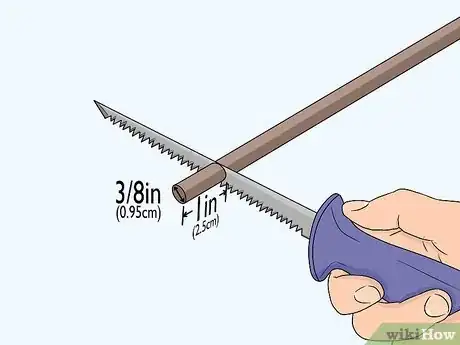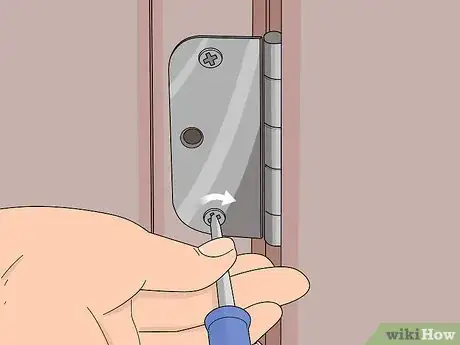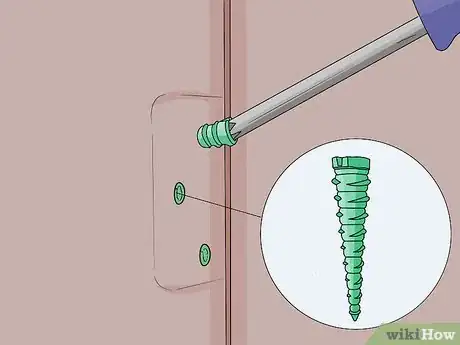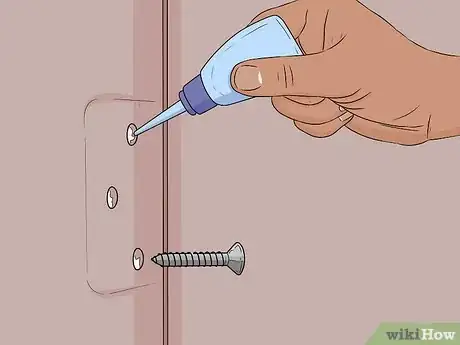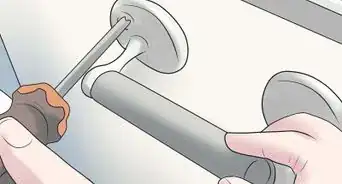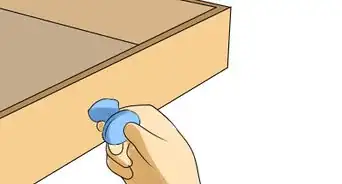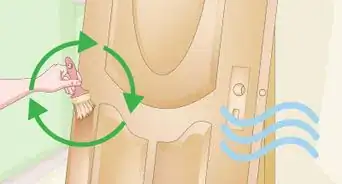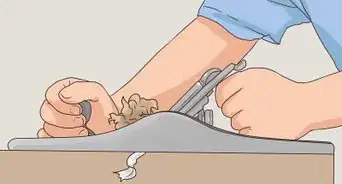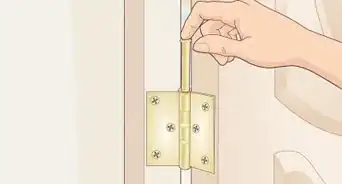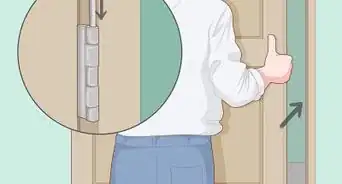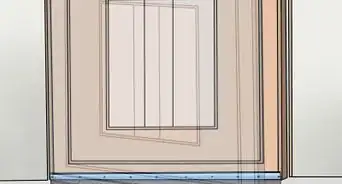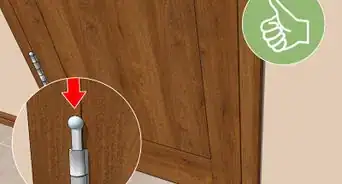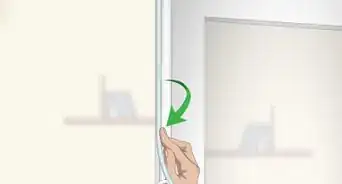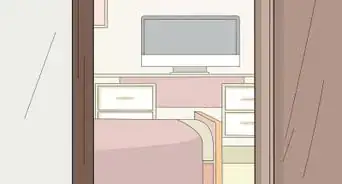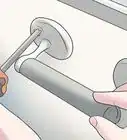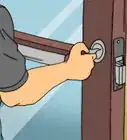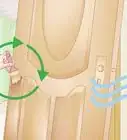This article was co-authored by Ryaan Tuttle. Ryaan Tuttle is a Home Improvement Specialist and the CEO of Best Handyman, Inc. in Boston, Massachusetts. With over 17 years of experience, he specializes in building home service businesses, focusing on creating scalable and efficient brands. With the help of his global team, the companies have achieved over 10+ million in sales and received recognition through magazine features, and enjoy partnerships with wikiHow and Jobber field service software. Boston Magazine and LocalBest.com have named Best Handyman Boston the Best Handyman in Boston. Ryaan holds Construction Supervisor and Home Improvement Contractor Licenses.
There are 9 references cited in this article, which can be found at the bottom of the page.
wikiHow marks an article as reader-approved once it receives enough positive feedback. In this case, 100% of readers who voted found the article helpful, earning it our reader-approved status.
This article has been viewed 697,417 times.
If you have a loose hinge and you can’t tighten it because the screws just spin in place, the screw holes are probably stripped. If the loose holes are in a solid piece of wood like a door frame, drill them out and fill them with wooden dowels to create a new surface for the screws to go into. If you want a quicker method that doesn’t require boring out the holes, try filling the stripped holes with golf tees, matchsticks or toothpicks, wood anchors, or cyanoacrylate glue. Use longer screws in the loose holes if they are just starting to get stripped.
Steps
Plugging Holes with Wooden Dowels
-
1Remove the loose screws and the hinge plate with a drill or screwdriver. Use a screwdriver or electric drill to unscrew the loose screws all the way. Set the screws aside and swing the hinge plate away so it’s not covering the loose holes.[1]
- If you are fixing just a few loose screw holes for something that has multiple hinges, like a door, you can put a wedge underneath it to support it while you unscrew the loose hinge and fix the stripped holes. If all the hinges have loose screws, it will be easier to just completely remove the door.
- If there is paint over the hinge, you can slice around it carefully with a utility knife or box cutter to free it so you can swing the plate away.
Tip: This method works best for hinges that are attached to a thick, solid piece of wood, such as a solid wooden door or door frame.
-
2Drill out the loose holes with a 3⁄8 in (0.95 cm) drill bit. Attach a 3⁄8 in (0.95 cm) drill bit to an electric drill. Drill straight into each of the stripped holes, going at least 1 in (2.5 cm) deep, to bore them out.[2]
- This will make all the stripped holes a uniform size that you can fit a piece of wooden dowel into perfectly.
Advertisement -
3Saw a 3⁄8 in (0.95 cm) diameter wooden dowel into 1 in (2.5 cm) long pieces. Measure and mark 1 in (2.5 cm) long sections along an entire piece of dowel. Use a hand saw or any type of power saw you have available to cut the pieces.[3]
- You will need a 1 in (2.5 cm) long piece of dowel for each loose hole you need to fix.
- If you use a handheld saw, clamp the wooden dowel to a workbench or put it in a vise to hold it steady while you cut the pieces.
- A wooden dowel is a round piece of wood that comes in rods of varying diameters and lengths. It is available at home improvement centers, woodworking supply and craft shops, or online. If you don’t have the tools to cut the dowel yourself, you can purchase pre-cut wooden dowels.
-
4Coat a 1 in (2.5 cm) long, 3⁄8 in (0.95 cm) diameter dowel in carpenter’s glue. Squeeze a drop of carpenter’s glue out onto the side of the piece of wooden dowel. Use your fingers or a scrap piece of dowel to spread the carpenter’s glue up and down the sides.[4]
- The carpenter’s glue will hold the dowel in place inside a stripped hole.
- You could also dip the dowel about halfway into a bottle of carpenter’s glue, then spread out the glue along the sides.
-
5Tap the wooden dowel into 1 of the holes gently using a hammer. Push 1 end of the piece of wooden dowel into 1 of the stripped holes. Carefully tap it in with a hammer until it is flush with the surrounding wood.[5]
- The wooden dowel will plug the stripped hole, essentially giving you a fresh surface to reattach the hinge to.
-
6Repeat the process for the rest of the stripped holes. Coat 1-inch-long, 3/8-inch-diameter pieces of wooden dowel in carpenter’s glue, 1 at a time, for each stripped hole. Use your hammer to tap each wooden dowel into each loose hole.[6]
- Make sure you get all the dowels flush with the surrounding wood, so the surface is totally flat.
-
7Wait for 1 hour to let the glue dry. Let the wooden dowels dry in the holes for at least 1 hour. This will ensure they are securely held in place when you reattach the hinge.[7]
- If there is any excess glue that oozed out of the holes, wipe it away with a rag so it doesn’t dry and make the surface uneven.
-
8Drill a 1⁄8 in (0.32 cm) pilot hole into each wooden dowel using an electric drill. Attach a 1⁄8 in (0.32 cm) drill bit to your electric drill. Drill straight into each wooden dowel that you plugged a loose hole with to create pilot holes for the hinge’s screws.[8]
- This will make it easier to reattach the hinge and get the screws in perfectly straight.
-
9Reattach the hinge using its screws. Position the hinge plate back over the reinforced holes. Put the screws back in through the holes in the hinge into the pilot holes in the dowel.[9]
Using Other Methods to Fix Loose Holes
-
1Plug holes with golf tees if the holes are big enough. Remove the loose screws and the hinge. Dip the tip of a golf tee into carpenter’s glue, tap it into a loose hole using a hammer, then snap off the excess wood sticking out of the hole. Reattach the hinge by driving screws through its holes into the golf tees after the glue is dry.[10]
- The golf tees will provide extra wood inside the stripped holes for the screws to grab onto.
- This method is a quick alternative to using wooden dowels that doesn’t require you to bore the holes out.
Tip: To make the tee perfectly flush with the surrounding wood, you can score the side of it with a utility knife right against the wood surface. This will make it easier to snap off the excess more evenly.
-
2Fill holes with toothpicks or matches to provide added grip for screws. Unscrew the loose screws and remove the hinge from on top of the stripped holes. Squeeze a drop of carpenter’s glue into each loose hole, then push about 3 wooden matches or toothpicks into the hole, or enough to fill it, and snap the excess wood off. Screw the hinge back into place after the glue is dry.[11]
- The extra wood from the matches or toothpicks helps the screws fit tightly into the stripped holes. You can use multiple matches or toothpicks in each hole if you need to fill the hole more.
- Make sure to snap off the match heads if you use wooden matches.
- This method works well for smaller holes that you don’t want to drill out to fill and risk damaging the wood. For example, you could use this to fix stripped holes on thin cabinet doors.
-
3Put wood anchors into stripped holes so the screws fit tightly. Buy some plastic, cone-shaped wood anchors that match the diameter of the hinge screws. Remove the hinge from on top of the loose holes. Screw a wood anchor into each loose hole until it won’t go any further, then bend it to snap it. Reattach the hinge by driving the original screws into the wood anchors and other holes.[12]
- Plastic, cone-shaped wood anchors work best because they fit into stripped holes of any diameter with no drilling required. There are also metal, cylindrical wood anchors available, but you would have to bore out each loose hole to the diameter of the anchors in order to use them.
-
4Fill loose holes with cyanoacrylate glue and reinsert the screws for a quick fix. Remove the screws and hinge, then squeeze enough cyanoacrylate glue into each loose hole to fill it. Let the glue cure for about 2 minutes, then screw the hinge back into place.[13]
- Cyanoacrylate glue is a fast-drying, ultra-strong glue that basically turns into a polymer resin when it is cured. It will hold the screws securely in place in the stripped holes.
- Super glue is a common name that different brands give to cyanoacrylate glue.
-
5Use longer screws to secure a hinge to loose holes. Remove any loose screws from the hinge using a screwdriver or drill. Replace them with a longer screw of the same diameter.[14]
- This works best for holes that are just starting to get stripped to prevent them from getting worse. The longer screw will bite into the deeper, unstrapped wood to hold the hinge more securely in place.
- Keep in mind that it may be difficult to find a longer screw that matches the original screws and the finish of the hinge. If this is important to you, you might be better off using a different method that allows you to keep the original screws.
Expert Q&A
-
QuestionWhat can I use if I don't have a wooden dowel?
 Ryaan TuttleRyaan Tuttle is a Home Improvement Specialist and the CEO of Best Handyman, Inc. in Boston, Massachusetts. With over 17 years of experience, he specializes in building home service businesses, focusing on creating scalable and efficient brands. With the help of his global team, the companies have achieved over 10+ million in sales and received recognition through magazine features, and enjoy partnerships with wikiHow and Jobber field service software. Boston Magazine and LocalBest.com have named Best Handyman Boston the Best Handyman in Boston. Ryaan holds Construction Supervisor and Home Improvement Contractor Licenses.
Ryaan TuttleRyaan Tuttle is a Home Improvement Specialist and the CEO of Best Handyman, Inc. in Boston, Massachusetts. With over 17 years of experience, he specializes in building home service businesses, focusing on creating scalable and efficient brands. With the help of his global team, the companies have achieved over 10+ million in sales and received recognition through magazine features, and enjoy partnerships with wikiHow and Jobber field service software. Boston Magazine and LocalBest.com have named Best Handyman Boston the Best Handyman in Boston. Ryaan holds Construction Supervisor and Home Improvement Contractor Licenses.
Home Improvement Specialist Use a golf tee and some wood glue. Squeeze a little bit of wood glue into the screw hole and onto the end of the golf tee. Then, hammer the golf tee into the screw so it's nice and tight. Snap off the part of the golf tee that's still sticking out, and let the wood glue dry. In a few hours, you can reinstall your screw.
Use a golf tee and some wood glue. Squeeze a little bit of wood glue into the screw hole and onto the end of the golf tee. Then, hammer the golf tee into the screw so it's nice and tight. Snap off the part of the golf tee that's still sticking out, and let the wood glue dry. In a few hours, you can reinstall your screw.
Things You’ll Need
Plugging Holes with Wooden Dowels
- Electric drill
- Wooden dowels
- Carpenter’s glue
- Saw
- Hammer
Using Other Methods to Fix Loose Holes
- Golf tees
- Carpenter’s glue
- Hammer
- Wooden toothpicks or matches
- Long wood screws
- Wood anchors
- Cyanoacrylate glue
- Screwdriver
References
- ↑ https://www.youtube.com/watch?v=WfX_hAgFf3Y&feature=youtu.be&t=24
- ↑ https://www.thisoldhouse.com/more/sure-cure-loose-hinges
- ↑ https://www.manmadediy.com/2194-how-to-repair-stripped-screw-holes-in-wood
- ↑ https://www.manmadediy.com/2194-how-to-repair-stripped-screw-holes-in-wood
- ↑ https://www.thisoldhouse.com/more/sure-cure-loose-hinges
- ↑ https://www.thisoldhouse.com/more/sure-cure-loose-hinges
- ↑ https://www.thisoldhouse.com/more/sure-cure-loose-hinges
- ↑ https://www.manmadediy.com/2194-how-to-repair-stripped-screw-holes-in-wood
- ↑ https://www.youtube.com/watch?v=WfX_hAgFf3Y&feature=youtu.be&t=248
- ↑ https://todayshomeowner.com/video/loose-hinge-repair/
- ↑ https://www.youtube.com/watch?v=OZKEu9YsED8&feature=youtu.be&t=51
- ↑ https://www.youtube.com/watch?v=lXecNkni4r4&feature=youtu.be&t=33
- ↑ https://www.woodmagazine.com/woodworking-how-to/shop-tips/super-quick-fix-for-stripped-screw-holes
- ↑ https://www.latimes.com/archives/la-xpm-1997-05-03-hm-54877-story.html
About This Article
You can repair a loose wood screw hole for a hinge by inserting a dowel to reinstall the screw or by relocating the hinge so it holds stronger. To remove the loose wood screw, drill out the stripped hole and glue in a dowel the same diameter as your drill bit. Then, glue and cut the dowel so it’s flush with the edge of the door or hinge. You can then drive the screw into the dowel to secure it. To relocate the hinge, remove the screws from the hinge and slide it up or down a few inches. You may need to re-chisel a pock in the frame so the hinge sits flush. Then, you can drive the screws into the screw holes on the hinge to secure it. To learn how to use a shim to repair a loose wood screw hole for a hinge, keep reading!


